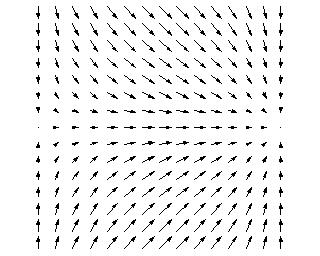Vector Field Function
A Vector Field Function is a vector-valued function that is a field function.
- Context:
- It can range from being a 2D Vector Field Function, to being a 3D Vector Field Function to being a k-Dimensional Vector Field Function.
- It can range from being a Divergent Vector Field Function to being a Constant Vector Field Function to being a Divergent Vector Field Function.
- It can range from being an Abstract Vector Field Function to being a Vector Field Function Structure.
- It can (often) be used to model a Physical Field (such as a magnetic field, gravity field or flow field)
- Example(s):
- The flow of a fluid can be considered as a constant vector field. Mathematically the field can be represented as [math]\displaystyle{ V=i+j }[/math].Here [math]\displaystyle{ i }[/math] and [math]\displaystyle{ j }[/math] are the unit vectors along x-axis and y-axis respectively. This is a constant vector field where each vector is of magnitude [math]\displaystyle{ \sqrt{2} }[/math] and direction [math]\displaystyle{ 45^o }[/math]angle with respect to x-axis.
- [math]\displaystyle{ V(\vec{x},\vec{y}) = x_i+y_j }[/math] is an example of a divergent vector field. In this vector field the vectors can have all possible magnitude and direction, pointing away from the origin.
- [math]\displaystyle{ V(\vec{x},\vec{y}) = -x_i-y_j }[/math] is an example of a convergent vector field. In this vector field the vectors can have all possible magnitude and direction, pointing towards the origin.
- [math]\displaystyle{ V(\vec{x},\vec{y}) = -y_i+x_j }[/math] such that [math]\displaystyle{ x_i^2 +y_j^2=1 }[/math] is an example of a rotational vector field. Here all the vectors are of unit magnitude and all possible direction but the starting point of a vector is the point on the circle [math]\displaystyle{ x_i^2 +y_j^2=1 }[/math].

- Counter-Example(s):
- See: Vector Calculus, Line Integral, Conservation of Energy, Fundamental Theorem of Calculus.
References
2015
- (Wikipedia, 2015) ⇒ http://en.wikipedia.org/wiki/vector_field Retrieved:2015-11-19.
- In vector calculus, a vector field is an assignment of a vector to each point in a subset of space. A vector field in the plane, for instance, can be visualized as a collection of arrows with a given magnitude and direction each attached to a point in the plane. Vector fields are often used to model, for example, the speed and direction of a moving fluid throughout space, or the strength and direction of some force, such as the magnetic or gravitational force, as it changes from point to point.
The elements of differential and integral calculus extend to vector fields in a natural way. When a vector field represents force, the line integral of a vector field represents the work done by a force moving along a path, and under this interpretation conservation of energy is exhibited as a special case of the fundamental theorem of calculus. Vector fields can usefully be thought of as representing the velocity of a moving flow in space, and this physical intuition leads to notions such as the divergence (which represents the rate of change of volume of a flow) and curl (which represents the rotation of a flow).
In coordinates, a vector field on a domain in n-dimensional Euclidean space can be represented as a vector-valued function that associates an n-tuple of real numbers to each point of the domain. This representation of a vector field depends on the coordinate system, and there is a well-defined transformation law in passing from one coordinate system to the other. Vector fields are often discussed on open subsets of Euclidean space, but also make sense on other subsets such as surfaces, where they associate an arrow tangent to the surface at each point (a tangent vector).
More generally, vector fields are defined on differentiable manifolds, which are spaces that look like Euclidean space on small scales, but may have more complicated structure on larger scales. In this setting, a vector field gives a tangent vector at each point of the manifold (that is, a section of the tangent bundle to the manifold). Vector fields are one kind of tensor field.
- In vector calculus, a vector field is an assignment of a vector to each point in a subset of space. A vector field in the plane, for instance, can be visualized as a collection of arrows with a given magnitude and direction each attached to a point in the plane. Vector fields are often used to model, for example, the speed and direction of a moving fluid throughout space, or the strength and direction of some force, such as the magnetic or gravitational force, as it changes from point to point.
2013
- (JavaView, 2013) ⇒ http://www.javaview.de/mathematica/tutorial/html/VectorField2D.htm
- QUOTE:
gv = PlotVectorField[{Sin[x], Cos[y]}, {x, 0, Pi}, {y, 0, Pi}];
- QUOTE:
2012
- (Li et al., 2012) ⇒ Deyi Li, Shuliang Wang, Wenyan Gan, and Deren Li. (2012). “Data Field for Hierarchical Clustering." Developments in Data Extraction, Management, and Analysis
- QUOTE: ... The data on objects are static independent of time. For the stable field with sources independent of time in space, there exists ascalar potential function φ (x) corresponding to the vector field function: Fx() that describes the intensity function. ...
1939
- (Orbisonillard, 1939) ⇒ William D. Orbisonillard. (1939). “Shape As a Function of the Vector-field." The American Journal of Psychology